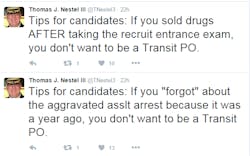Ever-changing technology impacts community relations for the police departments. Bay Area Rapid Transit (BART) Chief of Police Kenton W. Rainey said the biggest challenge they face is that everybody is so interconnected. “When something happens in Oakland, or San Francisco, or even across the country, people want to come back to BART because of that original high-profile event in 2009, Oscar Grant.
“We have to remind everybody, yeah, we did have that incident. But we’re totally a different agency. If you look at the stuff that was recommended in the president’s 21st Century Policing Task Force report, many of those recommendations we are either doing or have done.”
And some are using that kind of technology to their favor.
Southeastern Pennsylvania Transportation Authority (SEPTA) Chief of Police Thomas J. Nestel III came to SEPTA in August of 2012 and he was already using Twitter. “From the day that I walked in the door, that was one of the things that I was doing.
“And it does make the media relations folks, the CEOs, executive staff, it makes them nervous.”
He explained, “Look, I’m exposing myself and by exposing myself, I’m exposing my organization. One unintended blip could be a devastating disaster.”
He emphasized, “In order to have success, you have to take risk.
“It’s calculated risk and it’s reasonable risk, but it is risk.”
Nestel said the focus of his tweeting is to market the products and to let people know about the great work the transit police is doing on the system.
Measuring the return on investment of social media can be complicated, but Nestel and SEPTA Pbulic Information Manager Andrew Busch provided
SEPTA does a robust customer survey every couple years and the last survey saw a dramatic increase in customer satisfaction with safety and security. And, it’s not only built a relationship with the riders, it’s built a relationship with the media.
“It’s a mixed bag,” said Nestel. “Look, if I don’t tweet about it, it’s not a story.”
“Sometimes I’m tweeting about things just because I want people to know that I’m transparent. I put the good with the bad.”
Nestel referenced a recent example where he tweeted about the arrest of one of their own officers. He said, “The media would have never known about that had I not tweeted about it.”
Busch gave the media relations’ perspective. While they were nervous, it’s been tremendous in terms of increasing SEPTA’s profile, he said. Even when there’s an incident, not necessarily a positive event, since the chief’s been on board he said it’s put them on better footing. “It certainly has helped our credibility. We’re very much transparent.”
Credibility and transparency are key.
“You have to talk about the bad with the good,” Nestel said. “To be credible, sometimes you have to talk about the bad, too. And, you just can’t be a rosy, always-present person when good stuff is going on and then disappear when the bad stuff occurs.
As he explained, “It gives a great opportunity for me to give, in 140 characters, a short explanation or a short statement or a short expression of disappointment. I think it personalizes policing for me. “It sounds like a cute, catchy idea but it is very risky. However, the rewards can be overwhelming.”
Read the complete article Public Perception: What Transit Police are doing to Boost Community Relations at http://www.MassTransitmag.com/12159228.
